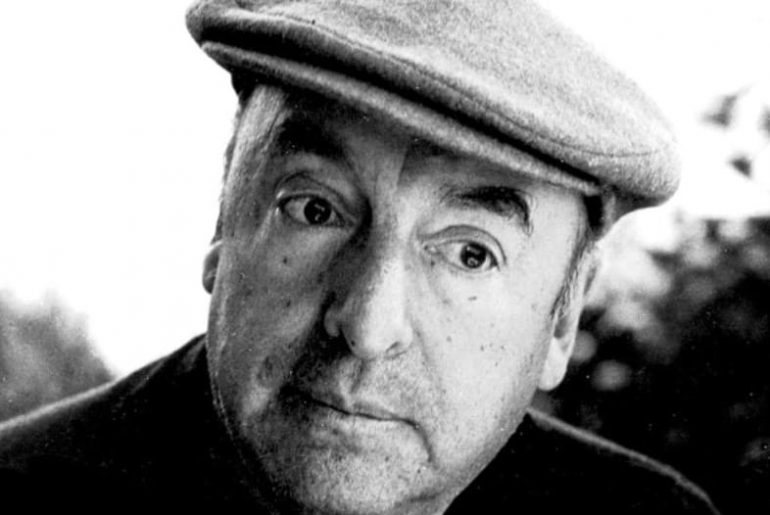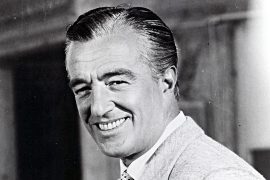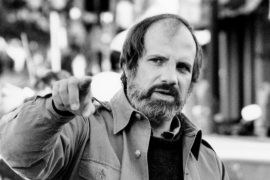The son of a Chilean railroad worker rose to become a recognized poet and diplomat, not only among the Chilean people. With his love poems and stories, Pablo Neruda knew in a unique way how to combine poetry and politics into an impressive work with universal significance for a global mass audience. In 1971, the life’s work of the diplomat and poet was crowned by the award of the Nobel Prize for Literature…
Neftalí Ricardo Reyes Basoalto was born on July 12, 1904 in the small town of Parral in southern Chile.
His father was a railroad worker. He lost his mother soon after his birth. Neruda grew up in Temuco, where he roamed the woods, befriended the Native Americans, and secretly began writing poetry. In 1919 he published his first poems in magazines, signing “Pablo Neruda”. In 1921, Neruda moved to the capital, Santiago, to attend teacher’s college there. In 1924, at the age of 20, he published the collection of poems “Veinte poemas de amor y una canción desesperada”, with which he first made a name for himself as an author of love poems.
Neruda then began to work as a translator and journalist for newspapers. He also published short stories and poems. In 1927 Neruda was appointed Honorary Consul of Chile to Rangoon, Burma (Myanmar). In 1930 he was appointed Consul of the Dutch East Indies. He married the Dutch Maria Antonieta Haagenar. In 1933/34 he took on diplomatic functions, first in Buenos Aires, then in Barcelona and Madrid. He processed the new impressions on such different continents in his three-volume collection of poems “Residencia en la tierra” (1933-1947). In Madrid, Neruda separated from his first wife to later marry Delia del Carril.
When his colleague and friend Federico García Lorca was murdered by the fascists in the course of the conflicts at the beginning of the Spanish civil war, the Chilean writer began to become increasingly politicized. After his return home, Neruda supported the struggle of the Spanish republicans from there in 1937/38. He began work on his major work “Canto general” (1950). In 1945 he was elected to the Senate of Chile. He joined the Communist Party and won the National Literature Prize. In the course of the anti-communist repression in Chile, Neruda had to go into hiding in 1948/49 and then flee to Mexico.
Although he was now celebrated all over the world, he was not able to return to Chile until 1952. In 1955, Neruda separated from Carril to live with Matilde Urrutia. He continued to travel extensively, taking him to the Soviet Union, China and South America. In the late 1960s Neruda also wrote for the theatre, for which he wrote Spanish translations of William Shakespeare. He also worked on his autobiography “Confieso que he vivido: Memorias”, which was published posthumously in 1974.
At the beginning of the 1970s, Neruda gave up his own candidacy in the Chilean presidential elections in order to support his friend Salvador Allende. He was then sent by the government as ambassador to France. In 1971 the life’s work of the diplomat and poet was crowned by the award of the Nobel Prize for Literature. Due to illness, he returned to Chile in 1972, where he still had to live through the assassination of Allende and the accession to power of the dictator Augusto Pinochet.
Pablo Neruda died on September 23, 1973 in a hospital in Santiago (Chile).
What is Pablo Neruda best known for?
Pablo Neruda, original name Neftalí Ricardo Reyes Basoalto, (born July 12, 1904, Parral, Chile—died September 23, 1973, Santiago), Chilean poet, diplomat, and politician who was awarded the Nobel Prize for Literature in 1971. He was perhaps the most important Latin American poet of the 20th century.
How did Pablo Neruda impact the world?
Neruda’s poetry directly influenced a great number of South American writers, Gabriel Garcia-Marquez, Julio Cortazar, and Isabel Allende among them. Neruda won the Nobel Prize for Literature in 1971, a controversial award because of his support of Stalin and his long-standing communist sympathies.
What type of poem is Pablo Neruda most famous?
Besides his epic romantic poetry, Neruda was famous for writing many different odes to foods and objects.
What type of poem is Pablo Neruda famous for and why?
Neruda became known as a poet when he was 13 years old, and wrote in a variety of styles, including surrealist poems, historical epics, overtly political manifestos, a prose autobiography, and passionate love poems such as the ones in his collection Twenty Love Poems and a Song of Despair (1924).
What are Pablo Neruda’s poems about?
Neruda wrote in a variety of styles such as erotically charged love poems as in his collection Twenty Poems of Love and a Song of Despair, surrealist poems, historical epics, and overtly political manifestos.
What is the tone of Pablo Neruda’s poem?
The tone is loving, but also incredulous, and a bit melancholy. “Every Day You Play” is a poem of love in which the poet praises his lover for accepting him with all his faults.
What is the central theme of the poem every day you play by Pablo Neruda?
‘Every Day You Play’ by Pablo Neruda describes the overwhelming love a speaker has for the listener and the way his life is improved by their relationship. The poem begins with the speaker describing how his love has elevated the listener beyond all others.





